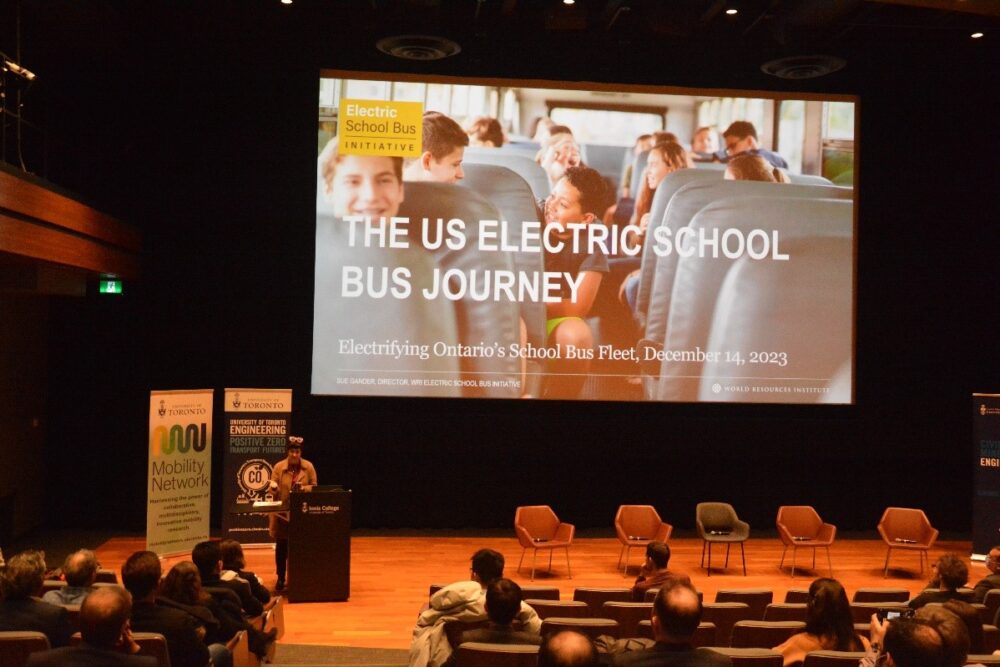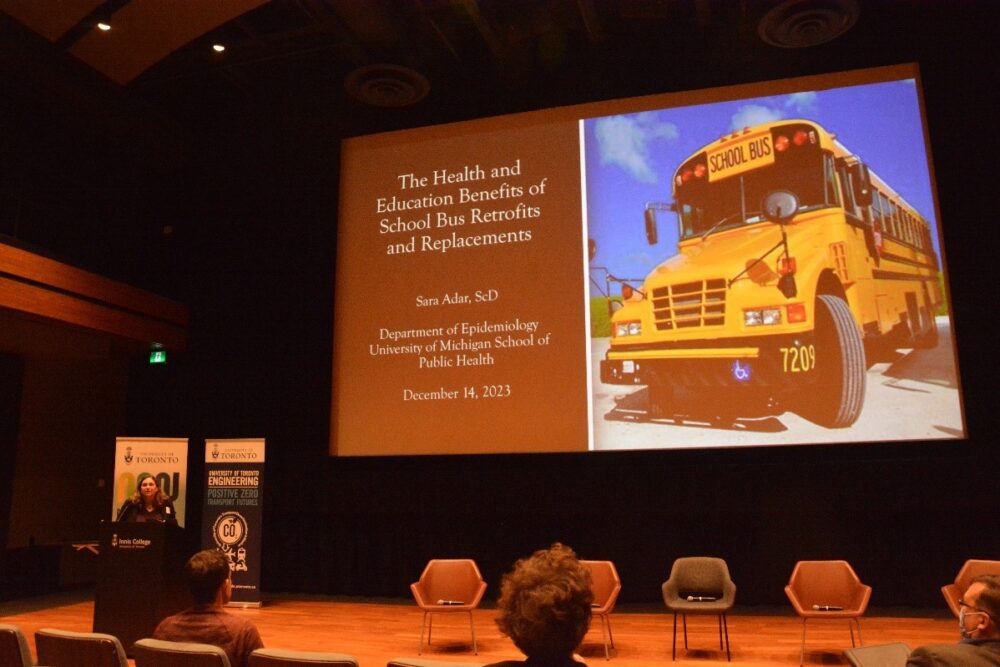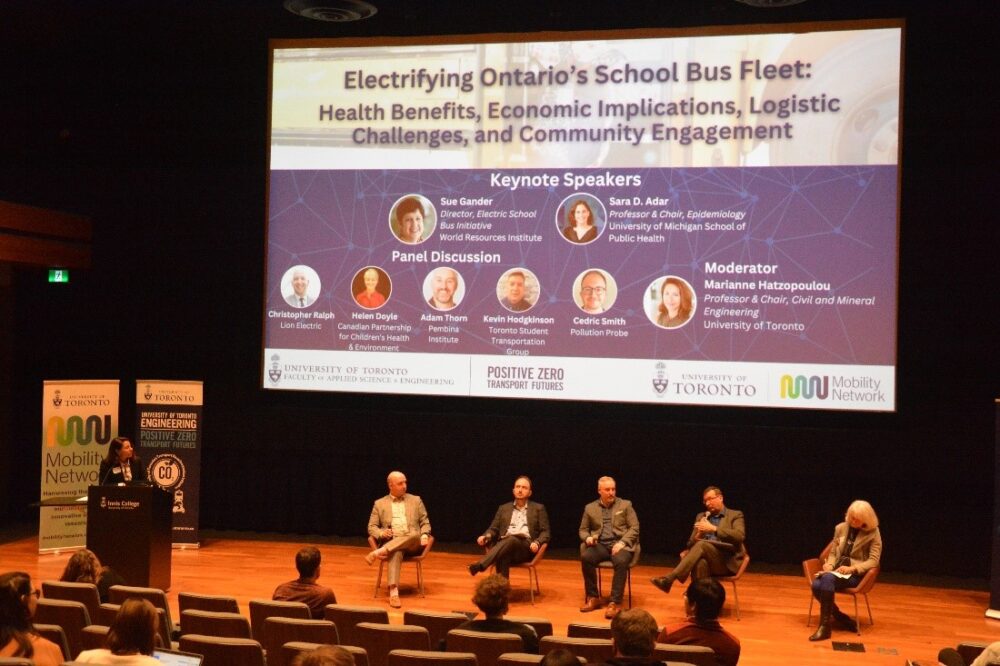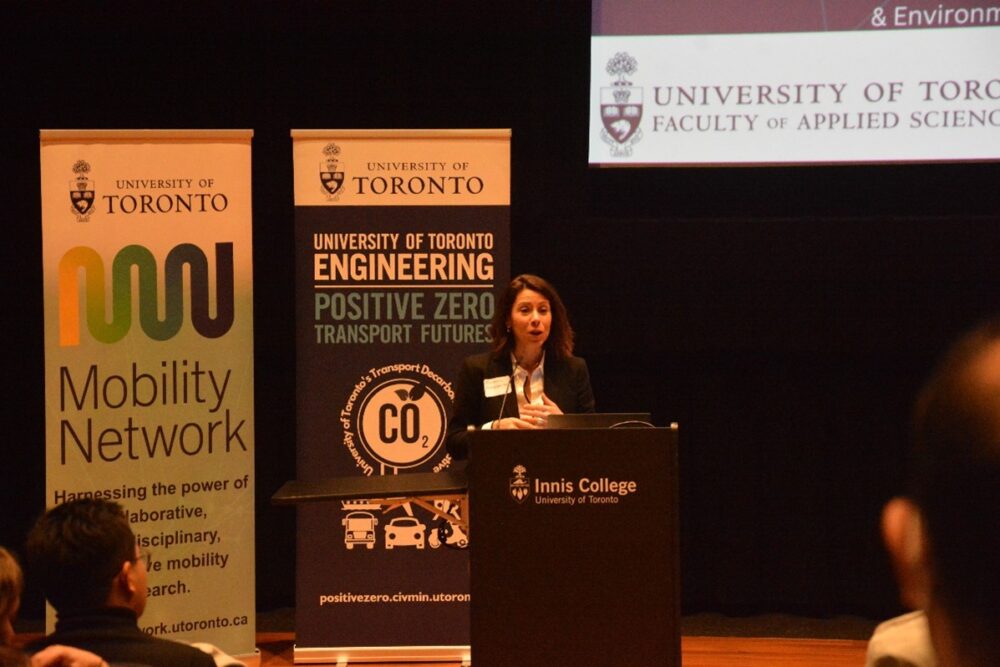Positive Zero Transport Futures, along with the Mobility Network, hosted “Electrifying Ontario’s School Bus Fleet” on December 14th, 2023, at the Innis Town Hall Theatre on the University of Toronto campus. The event brought together two keynote speakers and five expert panelists for an engaging discussion on the benefits and hurdles of electrifying the province’s school buses. The event welcomed over 80 attendees from academia, industry, government and community organizations. (Video recording available here)
Approximately 20,000 school buses carry over 833,000 students to school every day in Ontario, with over 90% of these buses running on diesel fuel. Air pollution from diesel buses has been linked to serious health impacts on the children they transport each day. The rapid deployment of electric school buses across Ontario’s school boards would protect children’s health, reduce carbon emissions, and strengthen the province’s automotive manufacturing industry. Beyond the numerous benefits electric school buses can provide, they offer a rich opportunity for community collaboration. While progress to electrify school buses is being made in other provinces, Positive Zero Transport Futures saw an important opportunity to discuss the delay in electrification of school buses in Ontario.
Dr. Marianne Hatzopoulou, Professor and Chair of the Civil and Mineral Engineering Department at the University of Toronto, welcomed attendees with opening remarks and moderated questions and discussions throughout the evening.
“We think about children’s health in terms of nutrition, we think about providing safe play spaces for them. Recently, we started becoming aware of the school environment, air purifiers, and indoor environments in which we operate. But I still think we haven’t yet made the connection to transportation,” said Dr. Hatzopoulou.
Our first keynote speaker, Sue Gander, is the Director of the Electric School Bus Initiative at the World Resources Institute. The Electric School Bus Initiative is aiming to electrify the entire U.S. fleet of 480,000 school buses by 2030. Sue shared with the audience the lessons her team has learned as part of this transition. As of today, the U.S. has 69,000 children riding the almost 6,000 electric school buses operating in nearly every state across the country.
Sue spoke to funding initiatives in place in the U.S., that while there are tremendous operational savings, “we need incentives to buy down the initial cost so that we can get this in place, and work to a place where there is cost parity.” Cautioning that “every time a new bus is bought, it’s on the road for 15 years.”
Challenges beyond the higher upfront cost include infrastructure development, learning new technology, and overcoming technology myths, each of which disproportionately impact underserved communities. Sue also shared on how her team has prioritized equity in the electric school bus transition. To learn more about some of Sue’s talking points on equity, you can check out this report that came out shortly after the event.

Dr. Sara Adar, our second keynote speaker, is an Associate Professor and Associate Chair of Epidemiology at the Michigan School of Public Health. Dr. Adar spoke primarily about the health and educational impacts of diesel buses on children, sharing results from two studies her group has conducted, one being a cohort study of 300 children in Washington school districts and the other being on national benefits of investments in cleaner school buses.
Dr. Adar’s team installed an air quality monitor on a bus, collecting measurements on over 600 rides. Switching from older diesel buses to newer, cleaner diesel buses reduced concentrations of harmful particles by 10% to 50%. Her team also found that switching to buses with clean fuels and technologies resulted in students being 5% to 10 % less likely to miss school, and children with severe asthma had 15% to 20% fewer absences. Extrapolating those results to the entire U.S. population, Dr. Adar’s team “estimated that the switch to cleaner fuels resulted in 14 million fewer absences per year.”
From 2012 through 2017, the EPA School Bus Rebate Program invested over $27 million to replace older diesel buses. Dr. Adar’s team found a slight overall improvement in attendance with the adoption of cleaner buses but a much larger improvement in areas where the oldest buses were replaced specifically. “Based on the EPA’s investment of $27 million, we estimate that we’re seeing $350 million in benefits only because of absenteeism alone.” Dr. Adar’s team hopes to extend their work to now look at the health and educational benefits of electric school buses.

The event featured five different panel speakers. Christopher Ralph is the Manager of Sustainable Mobility at Lion Electric, a top provider of electric school buses in North America. Adam Thorn, Director of Transportation at the Pembina Institue, spoke on their recent report strategizing the decarbonization of medium- and heavy-duty vehicles and the economic benefits of electric school buses for Ontario. Cedric Smith, Director of Transportation at Pollution Probe, shared recent findings from their electric school bus pilot project in Calgary. Kevin Hodgkinson, General Manager at the Toronto Student Transportation Group, spoke about how school boards and student transportation contracts operate in Ontario. Helen Doyle, a representative from Canadian Partnership for Children’s Health and Environment, spoke to health benefits of school bus electrification, including improved air quality, reduced climate change risks, and modelling climate-friendly behaviour to the next generation.
The panel discussion received questions from the audience around the proper disposal of the retired diesel buses. While they were not recommended for retrofits as long-range school buses due to issues surrounding lifespan and range, it was suggested that retrofitted buses may be able to be used in urban, small range scenarios such as shuttle services. The WRI’s Electric School Bus Initiative also recently announced their LEGO Build to Change, a free lesson plan to have classrooms brainstorm what can be done with the retired diesel buses.
The audience asked our panel speakers what, in their opinion, is the largest barrier to school bus electrification in Ontario. Barriers discussed included lack of tracking of health benefits, upfront costs, charging infrastructure, and myths surrounding the risks of electric school buses. “How do we find a methodology to capture those savings and transfer those cost benefits to the people that will do the heavy lifting?” Christopher Ralph (Lion Electric) speaks to shifting the cost burden off the operator and onto institutions that will gain from the health and operation benefits. “If you ask any of the operators most of them would agree they’re all on board with electrifying their school bus fleet. The issue is, there’s no money,” said Kevin Hodgkinson (Toronto Student Transportation Group).

The panel speakers spoke to the importance of government support to ramp up adoption of electric school buses in Ontario, similar to what has been done in the province of Quebec that has a plan to electrify 65% of their school buses by 2030. “That’s why something like a mandate can be so important. What you’re doing is you’re telling manufacturers that this is what you have to produce,” said Adam Thorn (Pembina Institute).
The panel speakers discussed issues around the logistics of electric school buses. While the electric school bus has a range of 200km, Cedric Smith (Pollution Probe) shared from the pilot project in Calgary that their team found buses had an actual range of 73km to over 200km. During the winter, buses need to be preheated. Below 10 degrees, the electrical heating system must be used, decreasing the range by a third. Vehicle-to-grid was also discussed. Lion Electric is currently using V2G in several states in the U.S., but the IESO is not quite ready for this technology from a policy standpoint in Ontario.
The audience also asked about maximizing health benefits for children, questioning if buses is the best way to accomplish this. The City of Toronto released new funding this year to increase active transportation to school. Several high school students in Toronto also use public transit to travel to school. Helen Doyle (CPCHE) shares that when discussing active transportation, we “can’t just talk about the physical activity benefits, we also need to talk about the air quality benefits and the climate benefits, because it’s all connected.”
The evening concluded with a networking reception catered by Acacia Café. Recordings of the keynote and panel speaker presentations can be viewed here. Positive Zero Transport Futures, a living lab approach enabling transport innovations with zero emissions and positive social outcomes, is proud to have brought together so many stakeholders in school bus electrification and provided a space for an engaging and overdue discussion.
This announcement originally posted by Positive Zero Transport Futures.

